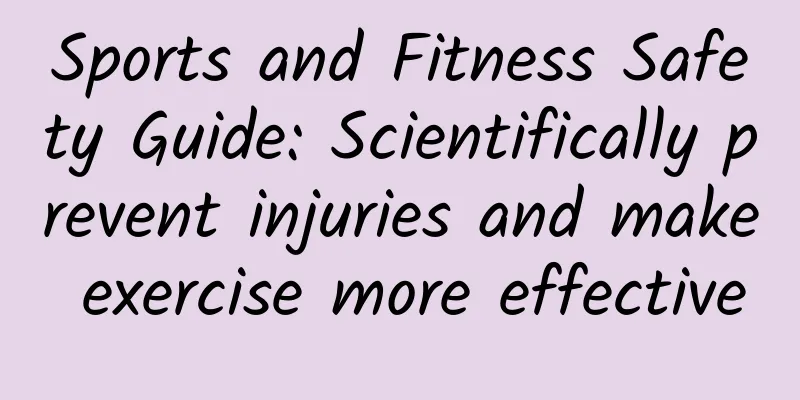Sports and Fitness Safety Guide: Scientifically prevent injuries and make exercise more effective

|
(The full text is about 2,000 words and the reading time is 6 minutes) When a 32-year-old running enthusiast terminated his training plan due to a ruptured Achilles tendon, and when a gym novice suffered a herniated disc due to incorrect squat posture, these real cases revealed that sports injuries often come from a lack of safety awareness. The essence of sports and fitness is to pursue health, but ignoring safety guidelines may backfire. 1. Before exercise: build a safety line of defense Medical assessment first: The American College of Sports Medicine recommends that people with BMI ≥ 30, hypertension, and sedentary people should undergo sports risk screening. It is recommended to assess cardiopulmonary function through a step test (measure heart rate recovery speed after walking up and down 30cm steps for 3 minutes). Project matching principle: People with a basal metabolic rate (BMR) lower than 1200kcal/day should start with low-intensity exercise (such as swimming and elliptical machines); patients with joint degeneration are recommended to exercise in water, which can reduce joint pressure by 90%. Scientific warm-up program: Use dynamic stretching to activate muscle chains, such as lunge rotation, which can simultaneously improve hip joint range of motion (ROM) and core temperature. Studies have shown that 10 minutes of dynamic warm-up can reduce the risk of muscle strain by 62%. 2. During exercise: accurately control risks Movement pattern optimization: Keeping the angle between the tibia and the parallel line of the torso ≤30 degrees during squats can reduce the shear force of the knee joint by 45%; during deadlifts, the barbell trajectory should pass vertically through the middle of the foot to avoid lumbar compensation. Intensity monitoring strategy: Use the heart rate reserve method (HRR = maximum heart rate - resting heart rate) × target intensity % resting heart rate, and control the moderate intensity in the 50-70% HRR range. If exercise tremor (involuntary muscle shaking) occurs, the load should be reduced immediately. Fatigue warning system: If the salivary α-amylase concentration exceeds 50 kU/L, it indicates that the sympathetic nerves are overexcited and the training should be terminated in time. If it takes more than 15 seconds to complete 8 standard push-ups in a row, it indicates that the muscle endurance has reached the critical point. 3. After exercise: system recovery project Neuromuscular reboot: PNF stretching (proprioceptive neuromuscular facilitation) can improve flexibility by 20% through the "contract-relax" technique (10 seconds of isometric contraction followed by 30 seconds of stretching). Soaking in cold water (10-15°C) for 10 minutes can reduce delayed onset muscle soreness (DOMS) by 37%. Nutritional time-space intervention: Intake of whey protein (0.3g/kg) and fast sugar (1.2g/kg) 30 minutes after exercise can increase the rate of muscle glycogen resynthesis by 300%. Electrolyte supplementation should follow a sodium-potassium ratio of 2:1, and 400-600ml of fluid should be supplemented for every 1L of sweat lost. Recovery monitoring indicators: If the morning pulse continues to rise by more than 5bpm or the HRV (heart rate variability) is 20% lower than the baseline value, it indicates insufficient recovery and the training plan should be adjusted. Conclusion: Sports safety is a precise system engineering that runs through "energy metabolism-biomechanics-neural regulation". From the FITT-VP principle (frequency, intensity, time, type, total amount, and progression) of the National Strength and Conditioning Association (NSCA) to the biomechanical model of sports injuries, scientific fitness requires the establishment of a three-dimensional protection system. Only when we internalize safety guidelines into sports instincts can we truly maximize health benefits. |
<<: "Pulled elbow": an inexplicable pain in young children!
>>: Don’t leave a cut lemon overnight! What does “leaving overnight” really mean?
Recommend
Why are girls getting their periods at younger and younger ages?
Why are more and more girls getting their periods...
Literature sharing: Rehabilitation diagnosis and treatment guidelines for adolescent idiopathic scoliosis
Literature sharing: Rehabilitation diagnosis and ...
Having sex at the end of your period
Even at the end of your period, you should not ha...
Will physical constitution affect women's morning sickness during pregnancy?
Morning sickness is a very normal reaction to pre...
Can peaches be put in the refrigerator? How to preserve them better? How to store peaches for a longer time?
Peaches can be eaten raw, but they can also be us...
I got pregnant after 4 dominant follicles were released.
Generally, before pregnancy, pregnant women will ...
What medicine should I take for a sore throat during breastfeeding?
During breastfeeding, some mothers may catch a co...
Are the glutinous rice balls of Duck and Dog delicious? Why are the glutinous rice balls of Duck and Dog so expensive?
Gangyagou glutinous rice balls are a specialty of...
How harmful is breast surgery to the body?
Breasts are the sexiest part of a woman, and ever...
What to do if the mother has little milk
For new mothers, the biggest worry is that their ...
What to eat during menstruation to lose weight the fastest and most effective
The menstrual period is a good time for women to ...
What are the causes of lower abdominal pain in women?
We often encounter women who are prone to lower a...
Can time-restricted eating improve metabolic function? New scientific evidence →
Nowadays, many people have disordered eating habi...
Does pelvic inflammatory disease require enema treatment?
Pelvic inflammatory disease is a common gynecolog...









